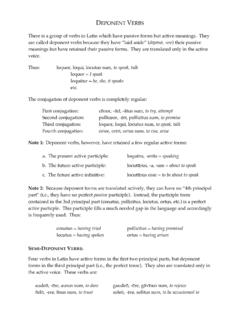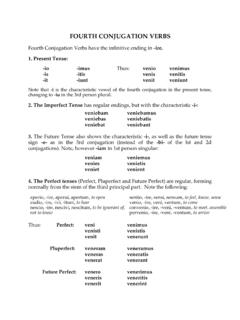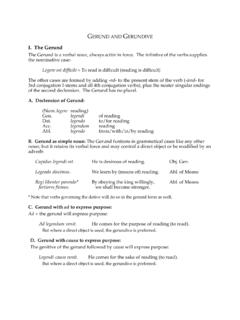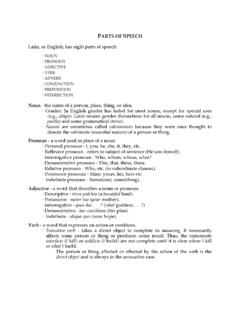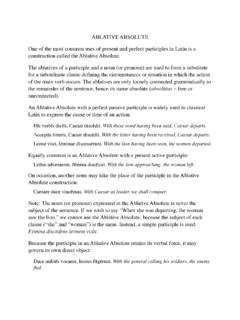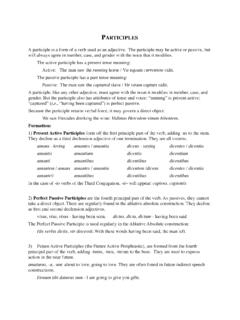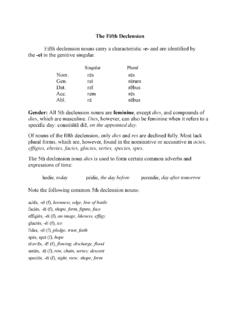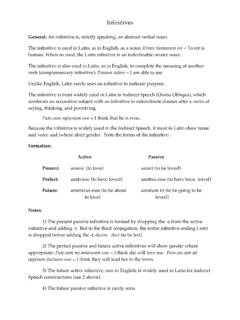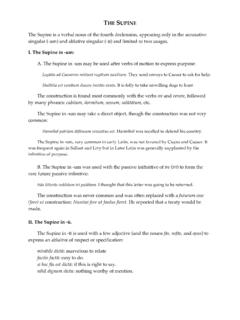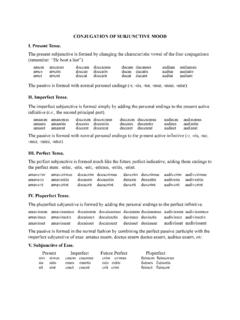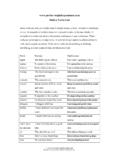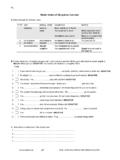Transcription of Third Conjugation Verbs - The Latin Library
1 Third Conjugation Verbs Third Conjugation Verbs have the infinitive ending in -ere. (Note the difference from the - re of the 2d Conjugation ).1. The Present tense has the characteristic vowel -i: - -imus Thus:duc ducimus-is -itisducis ducitis-it -untducit ducunt Note that the characteristic vowel -i- of the Third Conjugation in the present tense changes to -unt in the 3rd person plural. 2. The Imperfect tense is completely regular (with the short -e- of the infinitive lengthening to - - before the characteristic -ba- ending): duc bam duc b musduc b sduc b tisduc batduc bant3.
2 The Future tense differs significantly from what we have seen in the first and second conjugations. There the characteristic symbol was -bi-, inserted before the personal ending. For the Third Conjugation the characteristic vowel is -e- (with -am in the first personal singular): ducam duc musduc s duc tisducet ducent 4. The Perfect tenses (Perfect, Pluperfect and Future Perfect) form regularly from the the Perfect Stem (the Third principal part of the verb ). The Perfect Stem, however, shows many variations. Note the following: bib , ere, bib , to drinkmitt , ere, m s , missum, to sendcad , ere, cecid , c sum, to fallparc , ere perperci, parsum, to sparecaed , ere cec d , caesum, to cut, killpell , ere, pepul , pulsum, to drivec d , ere, cess , cessum, to gopet , ere, pet v , pet tum, to seek, askclaud , ere, claus , clausum, to close p n , ere, posu , positum, to putcr sc , ere, cr v , cr tum, to growquaer , ere, quaes v , quaes tum, to seek, askcurr , ere, cucurr , cursum, to runquaes , ere, quaes v , to beg, askd sist , ere, -stiti, -stitum, to desist, stoprelinqu , ere, rel qu , relictum.
3 To leaved c , ere, d x , dictum, to say, speaktang , ere, tetig , tactum, to touch d c , ere, d x , ductum, to leadtend , ere, tetend , t nsum, to stretch fall , ere, fefell , falsum, to deceivetrah , ere, trax , tr ctum, to draw, dragleg , ere, l g , lectum, to read; choose .. and many others 5. Third -io Verbs : Some 3rd Conjugation Verbs end in -io in the 1st pers. sing., present tense. They show -iunt in the 3rd pers. pl., present tense. The -i- also appears throughout the imperfect and the future tenses. The perfect tenses are regular, formed from the stem of the Third principal part.
4 Note the paradigm for facio, facere, feci, factum, to make, do: Present ImperfectFuturePerfectPluperfectFuture Perfect faci faci bam faciamf c f ceramf cer facisfaci b sfaci sf cistif cer sf cerisfacitfaci batfacietf citf ceratf ceritfacimus faci b mus faci musf cimusf cer musf cerimusfacitisfaci b tisfaci tisf cistisf cer tisf ceritisfaciuntfaci bantfacientf c runtf cerantf cerint Note the following common Third Conjugation -io Verbs :allici , allicere, allex , allectus, to attract, enticeaspici , aspicere, aspex , aspectus, to look at, behold*capi , capere c p , captus, to seize, capturecupi , cupere, cup v , cup tus, to long for, covetfaci , facere, f c , factus, to do, makefodi , fodere, f d , fossus, to dig (out)
5 Fugi , fugere, f g , fugitus, to flee, run awaygradior, grad , gressus sum, to walk, go, advance**iacio, iacere, i c , iactus, to throw**morior, mor , mortuus sum, to diepari , parere, peper , partus, to give birth topatior, pat , passus sum, to suffer, to undergoquati , quatere, , quassus, to shakerapi , rapere, rapu , raptum, to seize, snatchsapi , sapere, sap v , , to have sense, to be wise; to taste of*speci (not in use in classical Latin ) gave rise to: aspici , circumspci , dispici , conspic , inspici , respici , prospici .**gradior is in use, but its compounds are more common: aggredior, circumgredior, congredior, digredior, gredior, ingredior, progredior, regredior.
6 **the compounds of iacio are many: abicio, adicio, conicio, deicio, eicio, inicio, obicio, proicio reicio, traicio.
